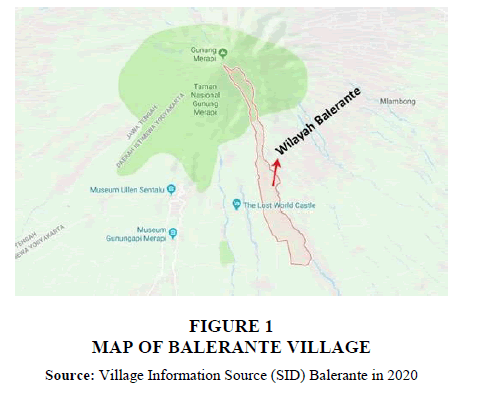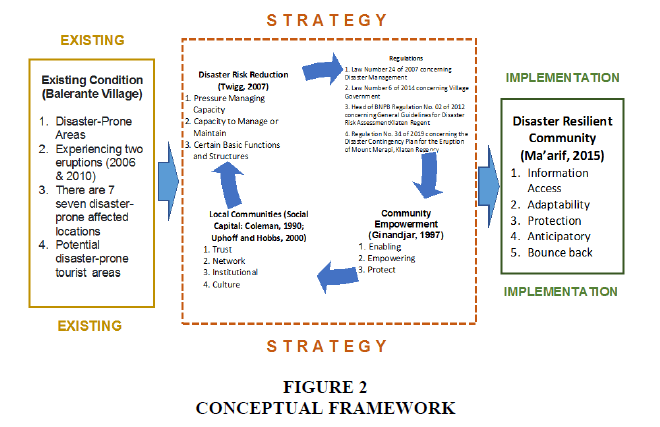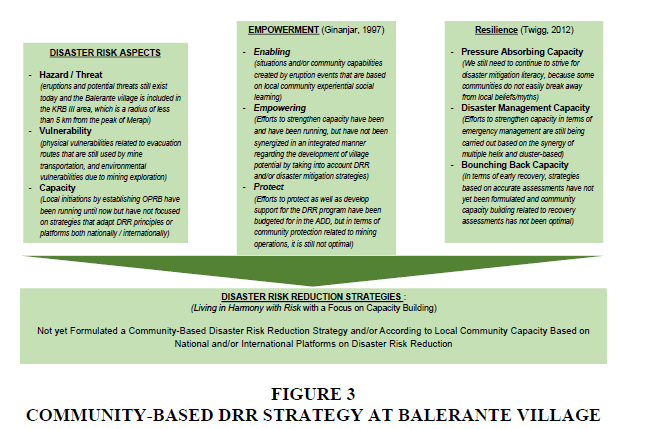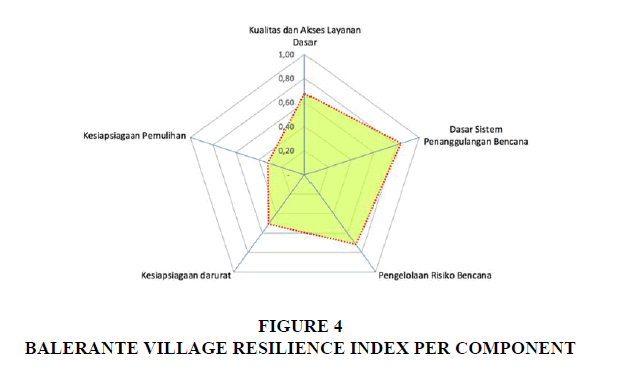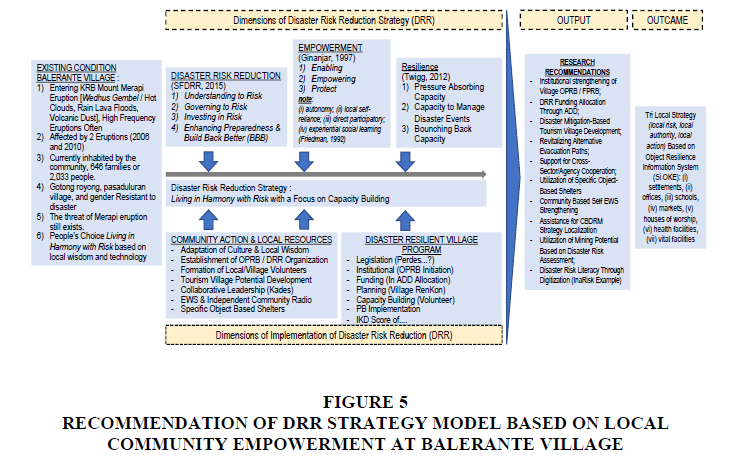Research Article: 2022 Vol: 25 Issue: 3
Strengthening community resilience at Balerante village, Klaten regency, Central Java province (Study case: Merapi volcano hazard)
Lilik Kurniawan, Universitas Brawijaya
Soesilo Zauhar, Universitas Brawijaya
Syamsul Maarif, Universitas Brawijaya
Lely Indah Mindarti, Universitas Brawijaya
Citation Information: Kurniawan, L., Zauhar, S., Maarif, S., & Mindarti, L. I. (2022). Strengthening community resilience at Balerante village, Klaten regency, Central Java province (Study case: Merapi volcano hazard). Journal of Management Information and Decision Sciences, 25(3), 1-12.
Abstract
Mount Merapi covers four regencies, i.e., Magelang, Boyolali and Klaten regencies in the Central Java Province, and Sleman Regency whereas in the Special Region of Yogyakarta Province. Based on the Catalog of Volcanic Disaster-Prone Villages (BNPB, 2019), there are 21 villages located in high-prone around Mount Merapi, including Balerante Village in Klaten Regency. This study aims to describe resilience component, analyze resilience object based on vulnerable location (settlement and public facility, and propose betterment innovative DRR strategy based on community empowerment at Balerante in facing Merapi hazard. This study used a qualitative approach, which intends to develop comprehensive description of the phenomenon. The result of the study found the most prominent resilience component is basic disaster management system that reaches the value of 0.84. This means, 84 percent of efforts in this component have been implemented within the community. Furthermore, there are seven vulnerable location-based objects to improve resilience, i.e., settlement, school/university, healthcare facilities, markets, house of worship, offices, and other vital facilities alongside three elements of locality: local risk, local authority, and local actions. DRR effort remains the gaps, such as the limitation of disaster knowledge for some residents and evacuation rehearsal is not implementable in regular basis. DRR strategies at Balerante can be improved through capacity building in each resilience objects and coordination within parties, stakeholders, and community in order to achieve more effective resilience in case of Merapi eruption.
Keywords
Community; Disaster risk reduction; Resilience; Eruption; Merapi.
Introduction
Mount Merapi is one of the most active volcanoes in Indonesia and has erupted more than 82 times since the 16th century (Voight et al., 2000). On average, the eruption of Mount Merapi in a short cycle occurs between 2-5 years, while the intermediate cycle occurs every 5-7 years. Mount Merapi first erupted in 1006, spewing lava and pyroclastic (locally known as wedus gembel), volcanic ash, and cold lava. The activity of Mount Merapi which occurred in October/November 2010 was recorded as the largest eruption since 1870 (Lavigne et al., 2000; BNPB, 2011).
The Mount Merapi area covers 4 (four) regencies, i.e., Magelang, Boyolali & Klaten Regencies in Central Java Province, and Sleman Regency in Special Region of Yogyakarta Province. Based on the Catalog of Volcanic Disaster-Prone Villages/District (BNPB, 2019; 2020), there are 156 villages located around disaster-prone area, which are classified into three levels: high hazard, medium hazard and low hazard. The determination of the hazard class is based on the KRB (Disaster Prone Area) of Mount Merapi designed by the Geological Agency, 2010, through combining flow-prone areas (effluent eruptions) and explosive eruptions.
The communities face direct and indirect hazards caused by volcano materials. Direct hazards represent pyroclastic, lava flows, falling rocks (incandescent), toxic gases and incandescent rocks. Meanwhile, indirect hazards can be in the form of rain, lava floods and landslides due to volcanic earthquakes. There are two types of volcanic eruption hazards, namely primary hazards and secondary hazards (Rahayu et al., 2014).
The disaster-prone area of Mount Merapi is home to 156 villages. Based on data from the Village Information System (SID) of Balerante that becomes the focus on this study (Figure 1), there are 6 hamlets with a total population of 505 people living in KRB III (the most hazardous zone). Historically, Balerante had been affected by pyroclastic in 2006’s and 2010’s explosion. As result of the occurrence of pyroclastic, 1 person died, dozens of houses heavily damaged, 382 cows died, and hundreds of people were forcibly being displaced.
After 2010’s tragedy, government initiated the relocation due to the hazard possibility in the future. This regulation aimed to relocate the residents to the safer place. However, some individuals disagreed on this effort considering the availability of livelihoods. Thus, the locals convince towards the notion “Living harmony with disaster”. In this consequence, the government remains to conduct more initiative in order to improve community capacity that focus on local community-based empowerment, which emphasizes disaster risk management as it is mandated on Sendai Framework for Disaster Risk Reduction (SFDRR). The implementation can be actualized through improving the quality of life, maintaining local wisdom which includes the values of social solidarity and mutual cooperation.
Methodology
This study emphasized empirical evidence in the event of existing and potential disaster at Balerante. The research gap that applied a regulatory perspective as well as various studies related to Disaster Risk Reduction (DRR) was involved. The conceptual framework (Figure 2) represents the correlation between existing condition, potential strategy, and implementation. The diagram shows how existing hazards in case of Merapi eruption creates the strategy that involves community empowerment, resilience, community capacity and government regulation. Those dimensions will further develop the implementation for Disaster Risk Reduction (DRR) efforts by government, particularly Local Disaster Management Agency (BPBD) in the community that lives in disaster-prone.
Local wisdom, social capital and resources are important issues to investigate local community-based DRR research. The study also explores the social capital, community empowerment, resilience, and regulation. The capacity likely develops the implementation of DRR efforts which consists of information access, protection, adaptability, anticipatory, and resilience at Balerante Village.
The main occupations of Balerante residents are farmers, farm laborers and ranchers. Morrover, the sand mining activity is one of the livelihoods of the people. The activity mostly uses traditional tools. The sand materials from Mount Merapi have further attracted mining corporations and eventually propose permits to government with modern equipment. However, this activity results the environmental damage, including roads and evacuation routes for the community.
Temporary evacuation plan designed in accordance to the KRB levels at respective hamlet considering population distribution data that accommodates 646 household’s in entire village. There are two locations of temporary evacuation at Balerante i.e., Balerante Village Hall and Shelter. The determination of temporary displacement is based on the distance of each hamlet for more effective mobilization when hazard dangers the community.
The resilience of community that includes gender-mainstreaming found in 2010’s eruption case. The role of women or mothers in helping families after the tragedy is dominant. Women residents produce economic value such as Merapi batik, coffee, and other agricultural products. More than that, women established women's farmer groups develops more advanced management of Village-Owned Enterprise (BUMDes). Apart from working for their families, Balerante women are able to become local leaders in the community.
Results and Discussion
The DRR strategy based on community empowerment at Balerante Village has been actualized through the commitment to settle in Disaster Prone Areas (KRB) III and/or safer place as it is mandated in the Minister of Public Works Regulation Number 21/PRT/M/2007 of 2007. As the consequence, the village government with the community remains to increase DRR capacity. This activity can be considered as resilience efforts at Balerante Village to the threats and potential impacts of Merapi eruption.
Community empowerment strategy at Balerante within the framework of disaster management takes into account of several important points, such as community participation in countinous and sustainable manners to promote the better DRR efforts. In dealing with the risk of Mount Merapi. At the same time, the phenomenon creates harmonious life living with the disaster risk. It eventually addresses the three aspects: enabling, empowering, and protecting (Figure 3).
The local community-based DRR strategy at Balerante Village should include resilience in facing of disasters and the aftermath. Community resilience can be obtained in accelerated manner when the residents perform adequate DRR activity, preparedness and skills in handling emergencies, as well as the ability to be able to recover quickly and independently (bouncing back) from the impact of a calamity.
To realize this resilience, there is a need for integration between the Village Government and the community, as well as external parties to focus on continuous efforts to build and improve the quality of disaster literacy as a whole for the people of Balerante Village. This followed by efforts to improve abilities, skills, and behaviour as a tangible manifestation of the capacity of local community-based disaster risk reduction, while maintaining culture as local wisdom becomes social capital for “Living Harmony with Disaster” (Figure 3).
Community involvement in disaster management is explicitly stated in Constitution Number 24 of 2007 regarding Disaster Management. It is mandated that preparedness activities are the responsibility of the government, regional governments, and are carried out together with the community and business institutions. The community is an important element in disaster management. The involvement must receive assistance from BPBD as the first responder as well as the leading sector in regional level.
Community resilience is measured through several dimensions, which focus on economic, social, institutional, environmental, infrastructure, communication, information, and community learning characteristics (Amadei, 2020; Toyoda, 2021; Jiang et al., 2022). Place-based understanding can be linked to the concept of local community, which consists of the organization of daily life and decision-making within a particular geographic location as well as the interactions between community members. Table 1 reveals the existing condition of Balerante, resilience as community capacity to cope a catastrophic event, and local community accountability.
| Table 1 Local Community Efforts To Increase Resilience At Balerante Village |
||
|---|---|---|
| The existing condition of Balerante Village | Resilience (Twigg, 2007) | Local Community Accountability |
| 1. KRB III is often hit by pyroclastic flows, lava flows, toxic gases and incandescent rocks. | 1. The capacity to absorb crushing stresses or crisis through resistance or adaptation. | Local knowledge. Balerante community understand the certain conditions of Merapi that have been experienced for decades living around volcano area. Titen-community awareness to predict natural hazard through observation - is part of people live. |
| 2. Natural tourism potential in disaster-prone areas. | 2. The capacity to manage, or maintain certain basic functions and structures, during the occurrence of a hazard. | Balerante people learn the obstacles of social change that arise from the impact of the Merapi disaster. Conduct an evaluative study of social changes to build resources affected by Merapi. A6+A63. Evacuation routes disrupted by sand mining activities |
| 3. Evacuation routes disrupted by sand mining activities | 3. Capacity to recover or bounce back after an event/disaster. | External factors provide understanding and reinforcement to the community regarding the development of programs that focus on sustainability and economic recovery. Encourage the implementation of accountable and transparent programs, especially in post-disaster economic recovery. B6 |
Local community at Balerante is responsible to design plan, monitor and evaluate the activities as a form of social changes to build the resources of the affected groups. The formation of OPRB is such initial activity in which village volunteers conduct regular meetings. This includes preparing a disaster information system by utilizing the use of Handy Talky (HT) communication tools for respective Head of Neighbourhood Association (RT), Head of Hamlet (RW) and Head of Village. Twigg (2007) states that resilience includes the capacity to manage, or maintain certain basic functions and structures.
OPRB and BPBD of Klaten Regency regularly implements a series of activity to improve knowledge related to disaster risk reduction in the community. In this way, OPRB, which has sufficient resource capacity, is then responsible for the integrity of the function and structure amongst the village community by providing socialization, training, and several activities in order to increase the capacity of residents.
Moreover, another initiative has been implemented through simulation to promote independent evacuation. This includes the introduction of EWS operations, the temporary shelter location, and how to perform self-evacuation when disaster occurs. The evacuation site has been involved COVID-19’s health protocols which becomes the newest innovation at Balerante in respect to displacement management.
The calculation of the resilience index of Balerante Village can be described in a spider's web based on the index per component in (Figure 4). The assessment was carried out through in-depth interviews with key figures (key informants) which include Village Leaders, Village Officials, Community Leaders, Youth Leaders, representatives of Family Welfare Programme (PKK), Religious Leaders, and the Head of OPRB at Balerante.
The result of the resilience assessment according to resilience index value (Figure 4) reaches the point of 65.71. Component of basic service and quality obtains a value of 0.68. Basic disaster management system represents the value of 0.84 which means 84% has been fulfilled and becomes the highest score amongst other proposed components. Moreover, the assessment towards disaster risk management issue stands on the value of 0.72. This means, 72 percent of indicators included in this point has been actualized 72%. Emergency preparedness achieves the value of 0.51 which addresses 51% of the indicators have been met. Recovery preparedness results the value of 0.32, which reveals that 68% of the proposed indicators have not been investigated. The values per component can be likely improved to the value of 1.00 in the future with the support from all parties, both internal at Balerante Village, as well as external including BPBD, private sector, academics from university, business institution, NGOs, and any other relevant agencies. There are noticeable points for respective component as the potential efforts in order to improve community resilience (Table 2).
| Table 2 Component And Efforts To Improve Resilience | |
|---|---|
| Component | Efforts |
| Basic Service Quality and Access | -Increase the number/quality of health care facilities, - Increasing the number of transportation facilities and infrastructure outside the authority of Balerante Village to provide access to the community, - Improve the quality of disaster information systems, - Strengthening the governance of Balerante Village with the support from Klaten Regency Government - Actively participate in collaboration with local and central governments to strengthen programs/activities regarding natural resources and environmental protection and management. |
| Basic Disaster Management System | - Disaster risk assessment for regional level by inviting neighboring villages that have the same disaster threat - Conduct periodic evaluation of DRR activities between villages in one area |
| Disaster Risk Management | -Carry out DRR activities by involving other villages in the same area - Identification of disaster knowledge and/or skills as a result of training |
| Emergency Preparedness | -Ensure that the dissemination of evacuation information reach all communities. - Strengthen the legality of evacuation routes and increase evacuation signs through policies at the village level - Carry out regular preparedness exercises involving all components. |
| Recovery Preparedness |
-Create a mechanism for preparing the Rehabilitation and Reconstruction Plan for all livelihood assets - Create a mechanism for assessing strategic and risky assets on all types of threats |
Social capital is an important part in formulating disaster risk reduction strategies. Balerante Village conducts this action, locally known as “Pasaduluran Village” (Sister Village). Based on the Klaten Regency Regional Secretariat Decree Number 368 of 2019, Balerante Village has a sister village or supporting village namely Kebondalem Lor Village. From the individual intervention, Balerante Village have shown a significant increase in capacity, which is indicated by better knowledge and understanding in regard to danger, self-evacuation mechanism, as well as potential and resources management to copy after the calamity.
The reception of the information amongst community thanks to the existence of radio alongside the accuracy of the news conveyed regarding disaster knowledge and other information related to latest activity of Mount Merapi. Community also involves in using sophisticated technology as well as record and manages data related to villages and population in form of Village Information System (SID). This innovation brings several benefits, i.e., securing data and information, and representing basic and sovereign data for contingency purposes when there is potential disaster of Merapi eruption.
Effective communication is influenced in several ways according to how message is received by the public. The availability and convenience of communication dissemination brings the motivation to protect themselves and other residents. From the economic and livelihood aspects, groups at Balerante manage the local economy by developing existing human and natural resources, such as the development of tourist villages, i.e., Kali Talang and the cultivation of coffee products and other plants, i.e., loncang, the promotion of local products, i.e., Merapi batik. The mentioned activities are parts of disaster preparedness savings.
Balerante Village as one of disaster-resilient village is in accordance with the Head of BNPB Regulation Number 1 of 2012. The existence disaster-resilient village aims to support the achievement of DRR goals. Villages can provide collective participation in relation to DRR efforts. As former explanation, the establishment of OPRB requires participation of all residents at the village.
Based on the findings, disaster happens when community are at home, schools, puskesmas (local clinic), hospitals, offices, worship places and other vital infrastructure facilities. As response, it is necessary to design improvements regarding DRR strategy based on infrastructure or places of community activity. There are seven vulnerable infrastructure objects: 1) house/settlement, 2) school/university, 3) Puskesmas (local clinic)/healthcare facilities, 4) market/trade facilities, 5) houses of worship (mosques, churches, temples, pagodas), 6) offices/village halls, and 7) other vital facilities (Table 3). However, the infrastructures can also be considered as resilience object.
| Table 3 Element Of Locality And Location-Based Resilience Object |
||||
|---|---|---|---|---|
| No | Locality Dimension/ Resilience Object | Elements of Locality in Disaster-Prone Areas | ||
| Local Risk | Local Authority | Local Actions | ||
| 1 | Settlement/ Housing | Vulnerable building stucture and geographical location to disaster brings large number of victims. The other factors represent lack of knowledge of family members on evacuation procedure and the existence of vulnerable groups in the family as well as limites access to government and other parties. | In Indonesia, head of family is positioned by a husband/father. This central position is very influential in providing DRR knowledge and command when a catastrophic event occurs. | Local government should strengthen the regulation regarding building code in any kinds of disaster through licensing process, such as Building Construction Permits (IMB) and Functionality Certificates (SLF) as well as ensuring the reliability of buildings including residential houses in disaster-prone. |
| 2 | House of worship | Churches, mosques and ther worship houses are mostly solid buildings and located in a strategic location. In many cases, these buildings are utilized for temporary shelter. However, some of buildings are also vulnerable. | The superintendent of a worship house is usually respected by the local community. This credibility enables to convince the residents in case of preparedness and response efforts. Therefore, the worship house can be used as a disaster information and education center as well as remporary shelter. | Some woeship places have made efforts to prmote DRR actions through sermons. In addition, volunteers from this infrastucture need to obtain DRR education and literacy and then transfered to local community. The simulation should be conducted whereas the meeting point or temporary shelter objects are the worship houses. |
| 3 | Medical/ healthcare facility | Healthcare officers less understand related to protocol for a disaster safe hospital. | Healthcare facility usually have structure organization, so there must be a commander when disaster happens or there is potential hazard. | Disaster simulations in healthcare facilities have been carried out quite often. However, it is still limited to internal situations, so that local actions that need to be developed are to involve residents or communities around healthcare facilities in scheduled simulations. |
| 4 | Market (Modern & Traditional) | In manu cases, most of traditional and modern markets often ignore disaster protocols. The intervention of DRR actions, particularly about self-evacuation should reach all traders and the visitors, for example the existence of meeting point and evacuation route, since the literacy regarding disaster in this environment is relatively low. | Even though there are market administrators and/or HPP (Market Traders Association), the 'structural' ties between traders and these administrators remains the gaps. This brings DRR practice is not optimally implemented. It is necessary to initiate the formation of market volunteers from the traders and collaborate with local institutions (for example BPBD and local universities) to provide assistance. | Re-mapping of threats in each zone in the market needs to be carried out and updatable. In addition, such initiative can be actualized through the availability of warning signs and regular-based simulations. Thematic Community Service Programs involving local universities can promote DRR literacy to the traders and visitors at the market. |
| 5 | School / Campus | Physical vulnerability related to school buildings is the main aspect that needs to be considered in addition to social and environmental vulnerabilities around the school. In Merapi case, many schools are located in a high risk of hazardous event. | Schools have a clear command structure and relatively obeyed by the students. Regular simulations and DRR literacy should be promoted to the teachers and students. Moreover, disaster curriculum may likely be such new innovation since in Indonesia the action is less practicable. | Scout community may involve for the promotion of DRR literacy and education for teachers and stucents. In addition, this activity, especially simulations are neccesarily important when the residents around the schools are being involved. |
| 6 | Office building | Disasters can destroy and damage office buildings or vital facilities. Besides its weak physical structure and/or location in disaster-prone, DRR education should be promoted to the people Besides, disaster crisis also affect office administration equipment and supplies, operational service cars, and archives. As the consequence, the activities and services will temporarily stop. | Local authorities, both private or government agencies are lack awareness towards this issue, especially offices buildings and vital facilities in term of disaster event. So that efforts to carry out prevention and emergency response activities can be coordinated and implemented properly, for example, establishing a task force or other division that is responsible for disaster mitigation in offices or vital facilities. | Every organization including government agencies and vital facilities must carry out risk mitigation arrangements or how each vital agency and facility handles risks in the event of an unexpected disaster. This work is possible as the annual work plan. Anticipatory actions aim ro reduce the risks and to provide services to the community. |
Resilience should be taken into account as mandatory capacity amongst residents in disaster-prone. Government, stakeholders, and consortium can develop DRR practice by implementing initial practice such as social mapping of each object of resilience in local level, i.e., house/settlement mapping. This action may utilize mapping-risk designed by BNPB called inaRISK. Furthermore, this technology “InaRISK Personal” application is available on Android’s Google PlayStore and iOS’s App Store. The community is now able to download and access this digital intervention to obtain information regarding disaster risk in all area throughout the Nation.
Figure 5 explains strengthening resilience object as part of local-based DRR strategy based on local community empowerment. This innovation aims to ensure “No One Leaves Behind” or zero risk. In case of eruption, the communities already have the capacity to save themselves, families relatives, and people around.
The proposed strategy in Figure 5 is the novelty of this study, and can be applicable to analyze in case of volcanic eruptions in other locations, or the other hazardous events such as tsunamis, floods, landslides, storm, and any other natural types. The potential risk in resilience objects in forms of settlement and public facility, e.g., school/university, healthcare facilities, markets/trade, houses of worship (mosques, churches, temples, and pagodas), offices/village halls, and vital facilities, can be reduced alongside the betterment practice of DRR efforts considering the places are inhabited by the residents. The implementation can be actualized through element of locality that covers local risk, local authority and local action.
Figure 5:Recommendation Of Drr Strategy Model Based On Local Community Empowerment At Balerante Village.
Conclusion
Study at Balerante regarding DRR strategy based on empowering local communities in case of Merapi eruption found that the function of the village must be able to facilitate the community to practice the notion “Living Harmony with Disaster”. As the consequence, it is very important efforts to strengthen the resilience of each village. Balerante has also been considered as Tangguh Madya Village (Disaster-Resilient Village) since DRR strategy involves individual, institutional, and location-based resilience.
The highest resilience component explored in this study represents basic disaster management system, which means mostly strategy (84 percent) regarding this point, has been implemented. The implementation of this component addressing the cooperation with neighboring villages that have the same disaster threat through “Paseduluran Village” (Sister Village) program. Moreover, the strategy also includes periodic evaluation of DRR activities between villages.
Second finding explored seven resilience objects which are place-based to improve the resilience capability amongst people. These objects include house/settlement, school/facility of education, healthcare facilities, market/trade, houses of worship (mosques, churches, temples, and pagodas), offices/village halls, and other vital facilities. The result reveals similarity and distinction in respective object. The similarity is in respect to the same hazard, in which Merapi’s prone-area. Meanwhile the differences reflect the risk, authority/management, and the actions.
Therefore, DRR effort remains the gaps, such as the limitation of disaster knowledge for some residents and evacuation rehearsal is not implementable in regular basis. DRR strategies at Balerante can be improved through capacity building in each resilience objects and coordination within parties, stakeholders, and community in order to achieve more effective resilience in case of Merapi eruption.
References
Amadei, B. (2020). A Systems Approach to Building Community Capacity and Resilience.Challenges,11(2), 28.
Indexed at, Google Scholar, Cross Ref
BNPB. (2011). Merapi Volcano Eruption Report. Jakarta: BNPB.
BNPB. (2019). Catalogue of Disaster-prone Area in Village/District Level. Jakarta: BNPB.
BNPB. (2020). Disaster Risk Index in Indonesia. Jakarta: BNPB.
Jiang, N., Ma, L. H., Cheng, J. X., & Jiang, X. L. (2022). A survey and cause analysis of community resilience in a Chinese city from the perspective of nursing.BMC public health,22(1), 1-10.
Indexed at, Google Scholar, Cross Ref
Lavigne, F., Thouret, J.C., Voight, B., Young, K., LaHusen, R., Marso, J., & Dejean, M. (2000). Instrumental lahar monitoring at Merapi Volcano, Central Java, Indonesia.Journal of Volcanology and Geothermal Research,100(1-4), 457-478.
Indexed at, Google Scholar, Cross Ref
Rahayu, S., Dewi, U., et al (2014). Tourism-based Development Strategy as Economic Empowerment in Kulon Progo. NATAPRAJA, 4.
Toyoda, Y. (2021). Survey paper: achievements and perspectives of community resilience approaches to societal systems.Asia-Pacific Journal of Regional Science,5(3), 705-756.
Indexed at, Google Scholar, Cross Ref
Twigg, J. (2007). Community Resilience Characteristic. DFID Disaster Risk Reduction Interagency Coordinator Group.
Voight, B., Constantine, E.K., Siswowidjoyo, S., & Torley, R. (2000). Historical eruptions of Merapi Volcano, Central Java, Indonesia, 1768–1998.Journal of Volcanology and Geothermal Research,100, 69-138.
